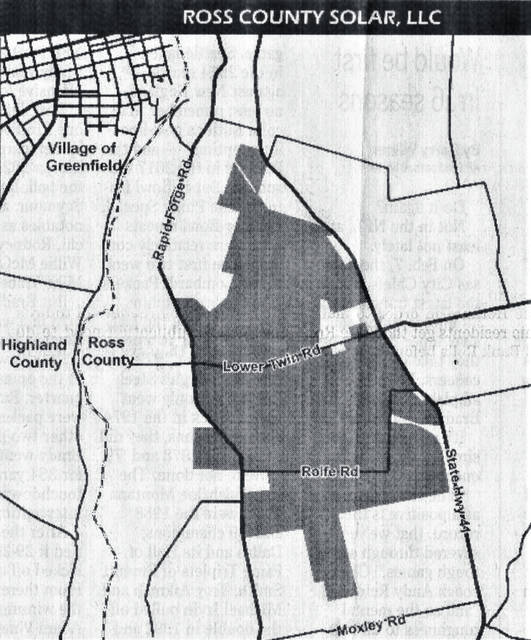
Tuesday night saw the first public hearing regarding the Palomino Solar Farm, the Highland County commissioners on Wednesday approved two road use maintenance agreements for the New Market Solar I and II farms, and a public hearing is set for April 6 concerning a Ross County solar project just south of Greenfield.
Among that flurry of activity, legislation has been introduced in both the Ohio House and Ohio Senate that could, if signed into law, hinder much of what has been characterized by developers as clean, renewable energy projects in the state and “jobs of the future” by the International Brotherhood of Electrical Workers.
According to the Ohio Legislature website, House Bill 118 and Senate Bill 52 seek to give local townships the ability to vote on whether or not utility-scale wind or solar projects will be coming to their communities by allowing residents to hold a referendum.
The House measure would go one step further by permitting township voters, through a referendum petition process, to overturn a decision of the Ohio Power Siting Board (OPSB) if it ruled that construction, operation or maintenance of a utility-scale energy facility was authorized in that township.
Jason Rafeld, executive director of the Utility Scale Solar Energy Coalition, said that both bills would have a chilling effect on the progress of solar energy development in Ohio.
“We believe that complex, utility-scale electric generation must be regulated at the state level,” Rafeld said. “We are looking at $18 billion in economic impacts, and almost 55,000 jobs through utility-scale solar development in Ohio.”
His comments came at the same time Tuesday when testimony was being heard in the Ohio Senate’s Energy and Public Utilities Committee about SB 52.
More than 100 people offered opinion and testimony in favor of giving local townships the final say as to whether wind turbines or solar panel fields will be coming to their jurisdictions, according to the Ohio Legislature.
Rafeld said the legislation was opposed by business, labor, agriculture, energy and education interests, and that Hecate, Innergex, RWE Renewables, Invenergy and National Grid Renewables — five corporations involved in solar projects in and around Highland County — have worked with farmers and communities to develop world class energy projects, while providing massive revenue for schools and local governments.
Mark Savion, director of legislative and regulatory affairs for Savion, LLC, described the permitting process of the OPSB as one of the most rigorous and extensive in the state.
“We have made agreements and decisions under current law, but we are being told that doesn’t matter,” Savion said. “This is a terrible signal to send to business in Ohio.”
One of the more than 40 questions raised during the Palomino hearing Tuesday night had to do with the future use of land once the solar farm lease expired, which typically is 35 years.
Jessica Gliha, director of community and government relations for Geenex Solar, wasn’t a part of the Tuesday night hearing, but described the panel farms as “the perfect placeholder of the future.”
“Solar development and construction processes make it one of the only land uses specifically designed to allow the land to return to its previous use as farmland in the future,” she said. “Solar developers are finding creative ways to work with communities — educational opportunities, workforce development programs, community benefit funds, residential solar programs, pollinator friendly habitats, sheep grazing habitats, natural screening and customized setbacks.”
She said that the changes proposed by both bills would result in lost jobs, lost revenues, lost economic opportunities for communities, and would unfairly harm businesses, workers, communities and Ohio landowners.
On the other side of the issue, in a transcript from Tuesday’s senate committee hearing, Seneca County resident Chris Aichholz told committee members that the utility-scale projects were reviewed and approved at the state level by individuals who were not elected, but appointed to the OPSB.
“Yet these board members, along with wind industry corporations from outside of Ohio, make all the decisions, without having full knowledge of local priorities held by area citizens,” Aichholz wrote.
Preble County farmer and township trustee Matthew Nixon testified that he wasn’t against solar energy production, but supported the idea of local determination.
“Under any scenario, local citizens must have a vote,” he said in written testimony. “People at the local level must have a voice, since they will have to deal with all aspects of the project during construction, operation and demolition.”
All three Defiance County commissioners submitted similar testimony to the Senate committee, acknowledging that “solar and wind energy projects are very polarizing for the local communities,” and advocating that local communities and governments need to have a say in any project prior to it moving forward.
They argued that either measure would not cause any financial hardships to the renewable energy companies, but would only add additional time to the projects’ beginning.
The next major event in the regional solar panel farm discussion will be Tuesday, April 6 at 6 p.m. when a hearing is scheduled by the OPSB for public testimony on the Ross County Solar project.
Ross County Solar is a proposed 120-megawatt, 1,400-acre facility to be located southeast of Greenfield across the Ross County line between Rapid Forge Road and SR 41.
As with Tuesday’s Palomino hearing, the Ross County Solar hearing will be held virtually on the Webex platform.
According to prime builder National Grid Renewables, anyone wanting to offer testimony for or against the project must preregister with the Public Utilities Commission of Ohio before noon Monday, April 5, at https://opsb.ohio.gov/wps/portal/gov/opsb/events/ross-county-solar-hearing, or by calling the PUCO at 800-686-7826.
The hearing will be livestreamed at www.youtube.com/user/PUCOhio.
Reach Tim Colliver at 937-402-2571.


